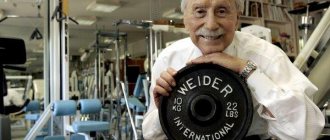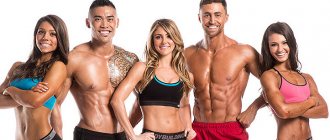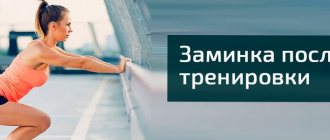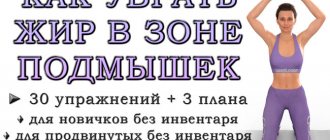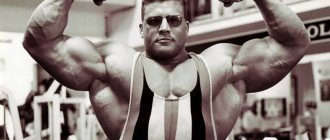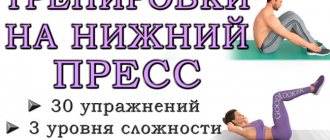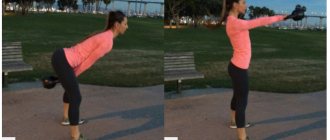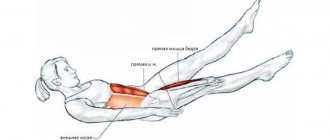Man has always strived for perfection and ideal, to become better, to move forward and develop. This applies to all areas of human activity, be it intellectual abilities or appearance, and we will talk about it in this article.
Over the centuries, ideal ideas about male and female figures have changed several times, but attempts to measure the human body and calculate its proportions have been made constantly. At all times, a man had the image of a strong, muscular and hardy person, this is eloquently demonstrated by ancient statues. Already in those days, athleticism was quite well developed and competitions were held in physical strength and dexterity.
A little history
The first attempts to depict ideal body proportions were made back in Ancient Greece by the sculptor Polycletus. The ideals of male beauty were embodied in a statue called Doryphoros (Spear-bearer). The proportions of the statue were presented in numerical ratios: according to Polycletus, the head was 1/8 of the height, the hand and face were 1/10, and the foot was 1/6. At the same time, the image of Doryphorus reflected not only brute male strength, but also personified health, energy and grace.
During the Renaissance, Leonardo da Vinci depicted a naked man in two positions, superimposed on one another: with arms and legs spread apart, inscribed in a circle; with arms apart and legs brought together, inscribed in a square. In this drawing, the author embodied his ideas about the ideal proportions of a person: height should be equal to the length of arms outstretched to the sides, the width of the shoulders should be equal to twice the width of the head, etc.
However, the first beauty contest for the male body and athletic build was held in 1901 in England, its founder was Evgeniy Sandov , a circus performer who had an excellent figure and amazing strength. In addition, he promoted a healthy lifestyle, became the author of methods for developing the body and opened a network of salons for physical education. It was this athlete who showed the general public the beauty of the male body and how physical exercise can change proportions in the required direction, building muscles in the right places. Perhaps this moment can be considered the birth of bodybuilding - bodybuilding.
The idea of building a beautiful body gained popularity much later, already in the post-war period. In 1946, Weider brothers began to actively promote the idea of a beautiful and muscular body to the masses and founded the International Federation of Bodybuilding (IFBB), and in 1965 they organized the Mr. Olympia competition. Bodybuilding athletes embodied the ideals of Greek sculptures, their symmetry, proportions and muscularity. The athlete had to look lean, without excess fat and a bulging belly, have broad shoulders, a cone-shaped back, a narrow waist and pelvis, and have developed legs.
What types of tables are there?
Shoe labeling tables exist for all occasions: men's, women's, children's, Russian, European and American. In case you didn't know, women's size 42 is smaller than the corresponding men's size. And boots made in China will be smaller than boots with the same size markings from a Russian or US manufacturer. Therefore, all the data must be carefully compared so that the new thing makes you happy and not sad, and does not end up on the mezzanine in a box, used only a couple of times. For convenience, the table can be printed on a small sheet of paper, which is placed in a notebook, wallet or handbag, so that you can always have it at hand if necessary.
Calculation of ideal proportions
Joe Weider Chart
For a more accurate assessment of proportions, several formulas based on measurements of one’s own body have been proposed. For example, Joe Weider offers his own table of ideal proportions . It looks like this:
| V/R | Neck | Hands | Forearms | Breast | Waist | Pelvis | Hip | Shin |
| 0.34 | 35.6 | 33.3 | 27.7 | 92.5 | 69.3 | 83.3 | 50.0 | 33.3 |
| 0.36 | 36.8 | 34.5 | 28.7 | 96.3 | 72.1 | 86.6 | 51.8 | 34.5 |
| 0.39 | 38.1 | 35.8 | 30.0 | 99.8 | 74.7 | 89.7 | 53.8 | 35.8 |
| 0.42 | 39.6 | 37.1 | 31.0 | 103.4 | 76.2 | 93.0 | 55.9 | 37.1 |
| 0.44 | 40.9 | 38.4 | 32.0 | 106.9 | 80.3 | 96.3 | 57.7 | 38.4 |
| 0.47 | 42.4 | 39.9 | 33.3 | 110.5 | 82.8 | 99.6 | 59.7 | 39.9 |
| 0.50 | 43.7 | 41.1 | 34.3 | 114.3 | 85.6 | 102.9 | 61.7 | 41.1 |
| 0.53 | 45.2 | 42.4 | 35.3 | 117.9 | 88.4 | 105.9 | 63.5 | 42.4 |
| 0.57 | 46.5 | 43.9 | 36.6 | 121.9 | 91.4 | 109.7 | 65.8 | 43.9 |
| 0.60 | 47.8 | 45.2 | 37.6 | 125.5 | 94.2 | 113.0 | 67.8 | 45.2 |
First, you need to divide your weight by your height, find the resulting figure in the leftmost column and calculate the ideal proportions for yourself. According to Joe Weider, ideally the proportions of bodybuilders should correspond to this table .
John McCallum Formula
In addition to Joe Weider's table, there are other formulas for calculating proportions. For example, John McCallum's formula , which is based on measuring the circumference of the wrist. It is assumed that the thickness of the wrist is closely related to the size of all human bones. However, sometimes there are people whose lower half of the skeleton is more massive than the upper and vice versa, so the proportions may vary. If you multiply your wrist circumference by 6.5, you get your chest circumference, from which you can calculate the circumference of the rest of your body. Based on this formula, the following patterns emerge:
- Waist circumference is 70% of chest circumference
- Hip circumference is 85% of chest circumference
- One hip equals 53% of the chest circumference
- The neck will be 37% of the chest
- Arm circumference is approximately 36% of chest circumference
- The shins will make up 34% of the chest
- Forearm equals 29% of chest
Table of Marcel Rouet
Marcel Rouet's version, we get the following table of proportions:
| Height | Weight | Hands | Neck | Breast | Waist | Hip | Shin |
| 165 | 65 | 35 | 35 | 105 | 75 | 55 | 35 1 |
| 166 | 65,5 | 35,5 | 35,5 | 106 | 76 | 55,5 | 35,5 |
| 167 | 68 | 36 | 36 | 107 | 77 | 56 | 36 |
| 168 | 69,5 | 36,5 | 36,5 | 108 | 78 | 56,5 | 36,5 |
| 169 | 71 | 37 | 37 | 109 | 79 | 57 | 37 |
| 170 | 72,5 | 37,5 | 37,5 | 110 | 80 | 57,5 | 37,5 |
| 171 | 74 | 38 | 38 | 111 | 81 | 58 | 38 |
| 172 | 75,5 | 38,5 | 38,5 | 112 | 82 | 58,5 | 38,5 |
| 173 | 77 | 39 | 39 | 113 | 83 | 59 | 39 |
| 174 | 78,5 | 39,5 | 39,5 | 114 | 84 | 59,5 | 39,5 |
| 175 | 80 | 40 | 40 | 115 | 85 | 60 | 40 |
| 176 | 81,5 | 40,5 | 40,5 | 116 | 86 | 60,5 | 40,5 |
| 177 | 83 | 41 | 41 | 117 | 87 | 61 | 41 |
| 178 | 84,5 | 41,5 | 41,5 | 118 | 88 | 61,5 | 41,5 |
| 179 | 86 | 42 | 42 | 119 | 89 | 62 | 42 |
| 180 | 87,5 | 42,5 | 42,5 | 120 | 90 | 62,5 | 42,5 |
| 181 | 89 | 43 | 43 | 121 | 91 | 63 | 43 |
| 182 | 90,5 | 43,5 | 43,5 | 122 | 92 | 63,5 | 43,5 |
| 183 | 92 | 44 | 44 | 123 | 93 | 64 | 44 |
| 184 | 93,5 | 44,5 | 44,5 | 124 | 94 | 64,5 | 44,5 |
| 185 | 95 | 45 | 45 | 125 | 95 | 65 | 45 |
In this case, the calculation is made according to the person’s height, and not according to his wrist circumference . The waist measurements according to this table of proportions are slightly higher than the others, it can be assumed that Ruhe is a follower of ancient proportions.
Body proportionality
Based on the numbers, we can say that the attractiveness of a particular athlete depends on his proportions. Since numbers are directly related to mathematics, proportions are described by a clearly formulated formula. The name of this formula is the golden ratio. The resulting number describes the human body as a whole and helps determine the proportions that can be considered the most correct by nature. The most striking example of a description of ideal proportions is the man of Leonardo da Vinci, who is depicted in a square and a circle. Thanks to this illustration, one can reveal the triumph of regular geometric shapes in human proportions. The so-called “golden ratio” determines the ratio 1:1.618. Thus, if we take the thigh as a unit, then the entire leg (thigh + lower leg) should be equal to 1.618 times the size of the thigh.
Read also: Bioavailability and bioequivalence
Since man is a rational being, the desire for harmony and symmetry is constant. That is why the beauty of the body is assessed based on the parameters prescribed by the golden ratio. If we talk about bodybuilding or fitness, then first of all, it is worth understanding that comprehensive muscle development comes first. The waist-to-shoulder ratio is especially pronounced. If you change this attitude, the development of body harmony will significantly advance in a positive direction.
Note
Depending on the body type, the plan for working on the muscles also changes. So it’s more logical for an ectomorph to start with pumping up the shoulders. An endomorph needs to reduce his waist size.
Having set the task of achieving ideal parameters, you first need to find out your personal parameters in order to find out which muscles you should focus on. And only after this can you draw up a specific training plan, choosing a particularly suitable program. All athletes who train in the gym differ from each other not only in their structure, but also in their physical fitness.
There are clearly defined proportions that will be as close as possible to harmonious:
- the volume of the pelvis should be nine tenths of the volume of the chest (that is, if the pelvis is 90 cm, then the chest should be 100 cm);
- - neck circumference should be 38% of chest circumference;
- - forearm circumference 30% of chest circumference;
- - waist 75% of chest circumference;
- - hips 60% of the pelvic volume;
- — the lower leg should ideally have a circumference equal to the circumference of the biceps in tension, or 40% of the pelvic circumference.
If we take into account ideal proportions, then the volumes of the neck, biceps and calves should be the same. If this is so, then we can say that the athlete is very well built athletically and his muscles are harmoniously developed.
You can also find out your ideal proportions based on weight and height from the following table (see table).
The “Weight/Height” ratio is the ratio of your weight (in kilograms) to your height (in centimeters). For example, your weight is 70 kg, and your height is 180 cm, which means that the value closest to your coefficient (0.388) is 0.39, therefore, we look at the proportions corresponding to it.
Thus, it became clear that knowing the ideal proportions is important, regardless of whether you plan to participate in competitions or train exclusively for yourself. But first you need to sort out the measurements that will be required for subsequent calculations.
Note
In all of the above proportionality tables, the lengths of the limbs must be proportionate to each other. For example, the length of the legs and torso should be the same; it is better for the legs to be slightly longer than the torso than vice versa. The arms should also not be too long or too short. The circumferences of the neck, arms and legs should be the same.
All measurements are taken with a flexible measuring tape, usually in the morning on an empty stomach. You should weigh yourself after visiting the restroom, and measure your girth “cold ,” that is, without first warming up with exercises. The measuring tape should be applied tightly, without sagging, but not too tightly.
- The wrist is measured with the hand bent into a fist, just above the bone at the thinnest point.
- When measuring neck circumference, you need to keep your head straight and measure the mid-transverse line of the neck.
- The forearm is measured with the arm extended and clenched into a fist.
- The girth of the arms is measured in a tense state, at the widest point, at the peak of the biceps.
- Chest circumference is measured in a standing position along the line of the nipples, without straining the muscles of the chest and back, without deep inhalation or exhalation, arms freely lowered along the body.
- The waist is measured at the narrowest point, without pulling in the abdomen.
- Pelvic circumference is measured across the buttocks, at its widest point.
- Thigh circumference is measured with the leg tense, directly under the buttocks7
- The shin is measured standing in a tense state, raised on the toes, at its widest point.
- The ankle is measured at its narrowest point, just above the foot.
The measurement locations are shown in the image:
Of course, no one forces you to correspond to all proportionality tables down to the millimeter, and this is unrealistic. All people are different, some have a more massive skeleton and a wide waist, others have the opposite. Despite the difference in body type, you should strive for broad shoulders and a narrow waist with a minimum amount of fat. With the help of physical exercises, you can, like a sculptor, create your body, adding muscles in the right places and removing excess. These are the variables that make a figure athletic and bring it closer to the ideal.
Spine in profile
From the side, the spine is shaped like a flattened letter S:
From the base of the skull, the line runs down and back until it reaches the farthest point at shoulder level. Please note that the shoulder joints protrude in front of the spine. This is because the shoulder line is actually an arc, as shown in the picture from above (in the blue circle).
The spine then protrudes forward again and protrudes slightly above the pelvis. This occurs at the lumbar level and the depth of the curve can vary, which can make it look like the character has an arched back. Finally, it changes direction again and ends at the tailbone.
Model, goddess or fatty: three types of physiques in women
In medicine, to determine the type of human constitution, as a rule, the method of M.V. Chernorutsky is used.
To establish a particular type of human physique, it is necessary to calculate the Pignier Index (PI). To do this, you need to know a person’s height (L, cm), his weight (P, kg), as well as his chest circumference (T, cm). The Pignier index can be determined using the formula: IP = L - (P + T).
With an PI value above 30, a person has an asthenic physique (hyposthenic or asthenic). If the PI varies from 10 to 30, this indicates a normal physique (normosthenic). When the IP is below 10, you have a person with a picnic body type (hypersthenic).
Three body types: asthenic, normosthenic, hypersthenic.
By determining the type of constitution of a person, you can calculate his optimal weight and determine the degree of need for figure correction.
Asthenic appearance or thin-boned.
Owners of such a body look elegant. The movements of asthenics are graceful and feminine. They retain their ease of gait until old age. It is girls with asthenic bodies who dominate the catwalks.
External signs of hyposthenics:
- long legs and arms;
- thin elongated fingers;
- narrow and long feet;
- thin and elongated neck;
- lack of muscle mass.
Girls with this type of physique are rarely prone to being overweight and are always energetic and active.
Normosthenic or normosthenic appearance.
This type is considered ideal, since all parts of the body look proportional and harmonious. This proportional type allows women to look great in any attire.
External signs of normosthenics:
- average height;
- proportional figure;
- slender strong legs;
- wasp waist.
Hypersthenic or broad-boned appearance.
The hypersthenic appearance is the opposite of the asthenic physique. Owners of this constitution have increased transverse dimensions of the body: the chest, shoulders and hip bone are quite wide. The thickened skeletal system is heavy.
External features of hypersthenics:
- low or average height;
- soft and round body;
- clearly visible fat deposits;
- a blurry body with a large belly;
- large round head with a flat contour of the crown;
- short massive neck;
- slightly short legs.
People with large bones are prone to excess weight.
You can only partially change your physique in early childhood with the help of certain types of training. The physique of an adult cannot be changed. The type of constitution, as a rule, remains until old age.
To find out what type of body type you have, just arm yourself with a measuring tape and measure the circumference of your wrist. If it is less than 16 cm, then you have an asthenic physique, the circumference of the wrist is from 16 to 18.5 cm - a sign of a normo-skeletal appearance, but if this parameter has reached 18.5 cm, then you have a hypersthenic type of physique.
Breast and navel
The chest and lungs are the third most important body shape after the head and pelvis:
In simplified form, this is an oval that starts exactly between one and two and ends at the third mark. But it's best to cut off the bottom of the oval, as shown in the image above, to imitate a real ribcage.
The empty space between the ribcage and pelvis is very important. It is soft and can be different: fat belly, soft belly or flat belly. And this is also the place where the spine is most mobile. You should remember this and do not connect the torso with the pelvis together, like two large blocks, as this will deprive your figure of plasticity. The width of the oval for the chest is still approximately the same as that of the pelvis.
A couple more details. The nipples are located on the o. To determine at what distance to place them from each other, draw two parallel lines from the sides of the head down, slightly going inside the contour of the head. And the navel falls on the third mark. Notice the blue dots on the right of the image.
How does body type relate to health risks?
WHR is most often used to determine degrees of obesity. WHO sets the following parameters:
- WHR>0.9 for men;
- WHR>0.85 for women.
Both indicators correspond to a body mass index (BMI) above 30, which indicates increased risks for a range of diseases from coronary heart disease and hypertension to diabetes and some types of cancer.
However, the waist ratio was more effective in determining risks in older people (over 75 years of age). WHR was also more useful in predicting cardiovascular disease.
WHO specialists also found that abdominal (abdominal) fat, typical for people with an “apple” figure, is more dangerous to health than peripheral fat. The higher the WHR, the worse.
Waist-to-hip ratio also correlates with fertility, with different values being optimal for women and men. With WHR>0.8, women's chances of becoming pregnant are significantly worse. At the same time, WHR>0.9 in men has practically no effect on their reproductive qualities.
Lee, JY, Istook, CL, Nam, YJ, and Park, SM, “Comparison of body shape between USA and Korean women,” International Journal of Clothing Science and Technology, Vol.19, No.5, 2007, pp. 374-391.
Yusuf S, Hawken S, Ounpuu S, Bautista L, Franzosi MG, Commerford P, Lang CC, Rumboldt Z, Onen CL, Lisheng L, Tanomsup S, Wangai P, Razak F, Sharma AM, Anand SS (November 2005). “Obesity and the risk of myocardial infarction in 27,000 participants from 52 countries: a case-control study.” Lancet. 366 (9497): 1640-9.
What do you need to know?
Digitizing the longitude of two limbs will make it possible to predict possible problems with the spine. When one leg is longer than the other, this can cause lower back pain in old age. Often such people are recommended to wear only special shoes or use special insoles with an orthopedic effect.
Have you heard that the owner of the longest legs is Svetlana Pankratova. She has a length of 1 meter, 32 centimeters and 5 millimeters with her height of 1 meter 96 centimeters. Long legs are charming and seductive, but their proportionality to the body is much more important. Otherwise, it doesn't always look beautiful.
And having completely intrigued you, we suggest below that you familiarize yourself with how to measure the length of your legs.
